
Fort Jefferson, Florida
Encyclopedia
Fort Jefferson is an unincorporated community and ghost town
in Monroe County
, Florida
, United States
. It is located on Garden Key in the lower Florida Keys
within the Dry Tortugas National Park
, about 70 miles (112.7 km) west of the island of Key West
.
Fort Jefferson is a massive but unfinished coastal fortress. It is the largest masonry
structure in the Western Hemisphere
, and is composed of over 16 million bricks.
sold
Florida
to the United States for $5 million, U.S. Navy
Commodore
David Porter
inspected the Dry Tortugas islands. He was on the lookout for a site for a naval station that would help suppress piracy
in the Caribbean
. Unimpressed with what he saw, he notified the Secretary of the Navy
that the Dry Tortugas were unfit for any kind of naval establishment. He reported that they consist of small sand islands a little above the surface of the ocean, have no fresh water, scarcely enough land to place a fortification, and in any case are probably not solid enough to bear one.
While Commodore Porter thought the Dry Tortugas were unfit for a naval station, others in the U.S. government thought the islands were a good location for a lighthouse
to guide ships around the area's reefs and small islands. A small island called Bush Key, later called Garden Key, was selected as the site for the lighthouse, which became known as Garden Key Light
. Construction began in 1825 and was completed in 1826. The 65-foot lighthouse was constructed of brick with a whitewashed exterior. A small white cottage for the lighthouse keeper was constructed beside the lighthouse.
In May 1829, Commodore John Rodgers
stopped at the Dry Tortugas to evaluate the anchorage. Contrary to Commodore Porter's experience, Rogers was delighted with what he found. The Dry Tortugas, he reported, consisted of 11 small keys and surrounding reefs and banks, over which the sea broke. There was an outer and an inner harbor. The former afforded a safe anchorage at all seasons, and was large enough to let a large number of ships ride at anchor. Of more importance, the inner harbor combined a sufficient depth of water for ships-of-the-line
, with a narrow entrance of not more than 120 yards. Rogers said that if a hostile power should occupy the Dry Tortugas, United States shipping in the Gulf would be in deadly peril, and "nothing but absolute naval superiority" could prevail. However, if occupied and fortified by the U.S., the Dry Tortugas would constitute the "advance post" for a defense of the Gulf Coast.
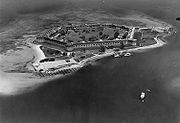 A series of engineering studies and bureaucratic delays consumed the next 17 years, but the construction of Fort Jefferson (named after the third President, Thomas Jefferson
A series of engineering studies and bureaucratic delays consumed the next 17 years, but the construction of Fort Jefferson (named after the third President, Thomas Jefferson
) was finally begun on Garden Key in 1846. The new fort would be built so that the existing Garden Key lighthouse and the lighthouse keeper's cottage would be contained within the walls of the fort. The lighthouse would continue to serve a vital function in guiding ships through the waters of the Dry Tortugas Islands until the current metal light tower was installed atop an adjacent wall of the fort in 1876. The original brick lighthouse tower was taken down in 1877.
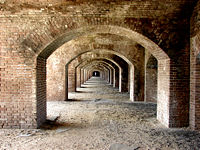 The design called for a three-tiered six-sided 410 heavy-gun fort, with two sides measuring 325 feet, and four sides measuring 477 feet. The walls met at corner bastion
The design called for a three-tiered six-sided 410 heavy-gun fort, with two sides measuring 325 feet, and four sides measuring 477 feet. The walls met at corner bastion
s, which are large projections designed to allow defensive fire along the faces of the walls they joined. The heavy guns were mounted inside the walls in a string of open casemates, or gunrooms, facing outward toward the sea through large openings called embrasure
s. Fort Jefferson was designed to be a massive gun platform, impervious to assault, and able to destroy any enemy ships foolhardy enough to come within range of its powerful guns.
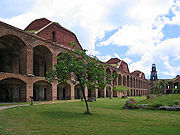
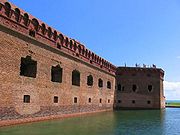
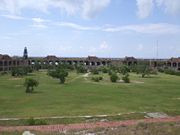 Living quarters for soldiers and officers, gunpowder
Living quarters for soldiers and officers, gunpowder
magazines, storehouses, and other buildings required to maintain the fort were located on the parade
ground inside the fort's massive brick walls. The Army employed civilian machinists, carpenters, blacksmiths, masons, general laborers, the resident prisoner population, and slaves
to help construct the fort. By 1863, during the Civil War
, the number of military convicts at Fort Jefferson had increased so significantly that slaves were no longer needed. At the time, there were 22 black slaves employed on the project.
Fort Jefferson's peak military population was 1,729. In addition, a number of officers brought their families, and a limited number of enlisted personnel brought wives who served as laundresses (typically four per company). There were also lighthouse keepers and their families, cooks, a civilian doctor and his family, and others. In all, there were close to 2,000 people at Fort Jefferson during its peak years.
In order to support such a large population in an area lacking fresh water, an innovative system of cisterns was built into the walls of the fort. Sand-filled columns were placed at regular intervals in the inner walls, spanning their height from the roof to the foundation. The columns were intended to filter rainwater from the rooftop for long-term storage in a series of underground chambers. However, the system was never used in practice, as the enormous weight of the outer walls caused them to subside; this created cracks in the cisterns, allowing seawater to contaminate the fresh water supply.
hands throughout the Civil War. With the end of hostilities in 1865, the fort's population declined to 1,013, consisting of 486 soldiers or civilians and 527 prisoners. The great majority of prisoners at Fort Jefferson were Army privates whose most common transgression had been desertion
, while the most frequent transgression for the civilian prisoners was robbery. However, in July 1865 four special civilian prisoners arrived. These were Dr. Samuel Mudd
, Edmund Spangler
, Samuel Arnold
, and Michael O'Laughlen
, who had been convicted of conspiracy in the assassination of President Abraham Lincoln
. Construction of Fort Jefferson was still under way when Dr. Mudd and his fellow prisoners arrived, and continued throughout the time they were imprisoned there and for several years thereafter, but was never completely finished. Mudd provided much-praised medical care during a yellow fever
epidemic at the fort in 1867, and was eventually pardon
ed by President Andrew Johnson
and released. By 1888, the military usefulness of Fort Jefferson had waned, and the cost of maintaining the fort due to the effects of frequent hurricanes and the corrosive and debilitating tropical climate could no longer be justified. In 1888, the Army turned the fort over to the Marine Hospital Service
to be operated as a quarantine
station.
, who visited the area by ship, designated the area as Fort Jefferson National Monument. It was listed on the National Register of Historic Places
on November 10 1970. On October 26 1992 the Dry Tortugas, including Fort Jefferson, was established as a National Park. The islands still do not exhibit any standing fresh water or even seasonal streams, hence the "dry" name. Owing to the potential difficulties of survival in such conditions, one of these islands was used as the location for filming a military survival film used to train aircraft personnel.
Ghost town
A ghost town is an abandoned town or city. A town often becomes a ghost town because the economic activity that supported it has failed, or due to natural or human-caused disasters such as floods, government actions, uncontrolled lawlessness, war, or nuclear disasters...
in Monroe County
Monroe County, Florida
Monroe County is a county located in the state of Florida. As of 2000, the population was 79,589. The U.S. Census Bureau 2006 estimate for the county was 74,737....
, Florida
Florida
Florida is a state in the southeastern United States, located on the nation's Atlantic and Gulf coasts. It is bordered to the west by the Gulf of Mexico, to the north by Alabama and Georgia and to the east by the Atlantic Ocean. With a population of 18,801,310 as measured by the 2010 census, it...
, United States
United States
The United States of America is a federal constitutional republic comprising fifty states and a federal district...
. It is located on Garden Key in the lower Florida Keys
Florida Keys
The Florida Keys are a coral archipelago in southeast United States. They begin at the southeastern tip of the Florida peninsula, about south of Miami, and extend in a gentle arc south-southwest and then westward to Key West, the westernmost of the inhabited islands, and on to the uninhabited Dry...
within the Dry Tortugas National Park
Dry Tortugas National Park
Dry Tortugas National Park preserves Fort Jefferson and the Dry Tortugas section of the Florida Keys. The park covers 101 mi2 , mostly water, about 68 statute miles west of Key West in the Gulf of Mexico....
, about 70 miles (112.7 km) west of the island of Key West
Key West
Key West is an island in the Straits of Florida on the North American continent at the southernmost tip of the Florida Keys. Key West is home to the southernmost point in the Continental United States; the island is about from Cuba....
.
Fort Jefferson is a massive but unfinished coastal fortress. It is the largest masonry
Masonry
Masonry is the building of structures from individual units laid in and bound together by mortar; the term masonry can also refer to the units themselves. The common materials of masonry construction are brick, stone, marble, granite, travertine, limestone; concrete block, glass block, stucco, and...
structure in the Western Hemisphere
Western Hemisphere
The Western Hemisphere or western hemisphere is mainly used as a geographical term for the half of the Earth that lies west of the Prime Meridian and east of the Antimeridian , the other half being called the Eastern Hemisphere.In this sense, the western hemisphere consists of the western portions...
, and is composed of over 16 million bricks.
Construction
In late December 1824 and early January 1825, about five years after SpainSpanish Empire
The Spanish Empire comprised territories and colonies administered directly by Spain in Europe, in America, Africa, Asia and Oceania. It originated during the Age of Exploration and was therefore one of the first global empires. At the time of Habsburgs, Spain reached the peak of its world power....
sold
Adams-Onís Treaty
The Adams–Onís Treaty of 1819, also known as the Transcontinental Treaty or the Purchase of Florida, was a treaty between the United States and Spain in 1819 that gave Florida to the U.S. and set out a boundary between the U.S. and New Spain . It settled a standing border dispute between the two...
Florida
Spanish Florida
Spanish Florida refers to the Spanish territory of Florida, which formed part of the Captaincy General of Cuba, the Viceroyalty of New Spain, and the Spanish Empire. Originally extending over what is now the southeastern United States, but with no defined boundaries, la Florida was a component of...
to the United States for $5 million, U.S. Navy
United States Navy
The United States Navy is the naval warfare service branch of the United States Armed Forces and one of the seven uniformed services of the United States. The U.S. Navy is the largest in the world; its battle fleet tonnage is greater than that of the next 13 largest navies combined. The U.S...
Commodore
Commodore (USN)
Commodore was an early title and later a rank in the United States Navy and United States Coast Guard and a current honorary title in the U.S. Navy with an intricate history. Because the U.S. Congress was originally unwilling to authorize more than four ranks until 1862, considerable importance...
David Porter
David Porter (naval officer)
David Porter was an officer in the United States Navy in a rank of commodore and later the commander-in-chief of the Mexican Navy.-Life:...
inspected the Dry Tortugas islands. He was on the lookout for a site for a naval station that would help suppress piracy
Piracy
Piracy is an act of robbery or criminal violence at sea. The term can include acts committed on land, in the air, or in other major bodies of water or on a shore. It does not normally include crimes committed against persons traveling on the same vessel as the perpetrator...
in the Caribbean
Caribbean
The Caribbean is a crescent-shaped group of islands more than 2,000 miles long separating the Gulf of Mexico and the Caribbean Sea, to the west and south, from the Atlantic Ocean, to the east and north...
. Unimpressed with what he saw, he notified the Secretary of the Navy
United States Secretary of the Navy
The Secretary of the Navy of the United States of America is the head of the Department of the Navy, a component organization of the Department of Defense...
that the Dry Tortugas were unfit for any kind of naval establishment. He reported that they consist of small sand islands a little above the surface of the ocean, have no fresh water, scarcely enough land to place a fortification, and in any case are probably not solid enough to bear one.
While Commodore Porter thought the Dry Tortugas were unfit for a naval station, others in the U.S. government thought the islands were a good location for a lighthouse
Lighthouse
A lighthouse is a tower, building, or other type of structure designed to emit light from a system of lamps and lenses or, in older times, from a fire, and used as an aid to navigation for maritime pilots at sea or on inland waterways....
to guide ships around the area's reefs and small islands. A small island called Bush Key, later called Garden Key, was selected as the site for the lighthouse, which became known as Garden Key Light
Garden Key Light
The Garden Key Light, also known as the Tortuga Harbor Light, is located at Fort Jefferson, on Garden Key in the Dry Tortugas, Florida. The first lighthouse, started in 1824 and first lit in 1826, was a brick conical tower. The lighthouse and its outbuildings were the only structures on Garden Key...
. Construction began in 1825 and was completed in 1826. The 65-foot lighthouse was constructed of brick with a whitewashed exterior. A small white cottage for the lighthouse keeper was constructed beside the lighthouse.
In May 1829, Commodore John Rodgers
John Rodgers (naval officer, War of 1812)
John Rodgers was a senior naval officer in the United States Navy who served under six Presidents for nearly four decades during its formative years in the 1790s through the late 1830s, committing the greater bulk of his adult life to his country...
stopped at the Dry Tortugas to evaluate the anchorage. Contrary to Commodore Porter's experience, Rogers was delighted with what he found. The Dry Tortugas, he reported, consisted of 11 small keys and surrounding reefs and banks, over which the sea broke. There was an outer and an inner harbor. The former afforded a safe anchorage at all seasons, and was large enough to let a large number of ships ride at anchor. Of more importance, the inner harbor combined a sufficient depth of water for ships-of-the-line
Ship of the line
A ship of the line was a type of naval warship constructed from the 17th through the mid-19th century to take part in the naval tactic known as the line of battle, in which two columns of opposing warships would manoeuvre to bring the greatest weight of broadside guns to bear...
, with a narrow entrance of not more than 120 yards. Rogers said that if a hostile power should occupy the Dry Tortugas, United States shipping in the Gulf would be in deadly peril, and "nothing but absolute naval superiority" could prevail. However, if occupied and fortified by the U.S., the Dry Tortugas would constitute the "advance post" for a defense of the Gulf Coast.

Thomas Jefferson
Thomas Jefferson was the principal author of the United States Declaration of Independence and the Statute of Virginia for Religious Freedom , the third President of the United States and founder of the University of Virginia...
) was finally begun on Garden Key in 1846. The new fort would be built so that the existing Garden Key lighthouse and the lighthouse keeper's cottage would be contained within the walls of the fort. The lighthouse would continue to serve a vital function in guiding ships through the waters of the Dry Tortugas Islands until the current metal light tower was installed atop an adjacent wall of the fort in 1876. The original brick lighthouse tower was taken down in 1877.
Design

Bastion
A bastion, or a bulwark, is a structure projecting outward from the main enclosure of a fortification, situated in both corners of a straight wall , facilitating active defence against assaulting troops...
s, which are large projections designed to allow defensive fire along the faces of the walls they joined. The heavy guns were mounted inside the walls in a string of open casemates, or gunrooms, facing outward toward the sea through large openings called embrasure
Embrasure
In military architecture, an embrasure is the opening in a crenellation or battlement between the two raised solid portions or merlons, sometimes called a crenel or crenelle...
s. Fort Jefferson was designed to be a massive gun platform, impervious to assault, and able to destroy any enemy ships foolhardy enough to come within range of its powerful guns.



Gunpowder
Gunpowder, also known since in the late 19th century as black powder, was the first chemical explosive and the only one known until the mid 1800s. It is a mixture of sulfur, charcoal, and potassium nitrate - with the sulfur and charcoal acting as fuels, while the saltpeter works as an oxidizer...
magazines, storehouses, and other buildings required to maintain the fort were located on the parade
Parade (military)
A military parade is a formation of soldiers whose movement is restricted by close-order manouevering known as drilling or marching. The American usage is "formation or military review". The military parade is now mostly ceremonial, though soldiers from time immemorial up until the late 19th...
ground inside the fort's massive brick walls. The Army employed civilian machinists, carpenters, blacksmiths, masons, general laborers, the resident prisoner population, and slaves
History of slavery in the United States
Slavery in the United States was a form of slave labor which existed as a legal institution in North America for more than a century before the founding of the United States in 1776, and continued mostly in the South until the passage of the Thirteenth Amendment to the United States Constitution in...
to help construct the fort. By 1863, during the Civil War
American Civil War
The American Civil War was a civil war fought in the United States of America. In response to the election of Abraham Lincoln as President of the United States, 11 southern slave states declared their secession from the United States and formed the Confederate States of America ; the other 25...
, the number of military convicts at Fort Jefferson had increased so significantly that slaves were no longer needed. At the time, there were 22 black slaves employed on the project.
Fort Jefferson's peak military population was 1,729. In addition, a number of officers brought their families, and a limited number of enlisted personnel brought wives who served as laundresses (typically four per company). There were also lighthouse keepers and their families, cooks, a civilian doctor and his family, and others. In all, there were close to 2,000 people at Fort Jefferson during its peak years.
In order to support such a large population in an area lacking fresh water, an innovative system of cisterns was built into the walls of the fort. Sand-filled columns were placed at regular intervals in the inner walls, spanning their height from the roof to the foundation. The columns were intended to filter rainwater from the rooftop for long-term storage in a series of underground chambers. However, the system was never used in practice, as the enormous weight of the outer walls caused them to subside; this created cracks in the cisterns, allowing seawater to contaminate the fresh water supply.
Active Use: 1860s - 1930s
The fort remained in FederalUnion (American Civil War)
During the American Civil War, the Union was a name used to refer to the federal government of the United States, which was supported by the twenty free states and five border slave states. It was opposed by 11 southern slave states that had declared a secession to join together to form the...
hands throughout the Civil War. With the end of hostilities in 1865, the fort's population declined to 1,013, consisting of 486 soldiers or civilians and 527 prisoners. The great majority of prisoners at Fort Jefferson were Army privates whose most common transgression had been desertion
Desertion
In military terminology, desertion is the abandonment of a "duty" or post without permission and is done with the intention of not returning...
, while the most frequent transgression for the civilian prisoners was robbery. However, in July 1865 four special civilian prisoners arrived. These were Dr. Samuel Mudd
Samuel Mudd
Samuel Alexander Mudd I, M.D. was an American physician who was convicted and imprisoned for aiding and conspiring with John Wilkes Booth in the 1865 assassination of U.S. President Abraham Lincoln. He was pardoned by President Andrew Johnson and released from prison in 1869...
, Edmund Spangler
Edmund Spangler
Edmund Spangler , also known as Edman, Edward, and Ned Spangler, was originally from York, Pennsylvania, but he spent the majority of his life in the Baltimore, Maryland area...
, Samuel Arnold
Samuel Arnold (Lincoln conspirator)
Samuel Bland Arnold was involved in the plot to kidnap President Abraham Lincoln in 1865.He and the other conspirators, John Wilkes Booth, David Herold, Lewis Powell, Michael O'Laughlen and John Surratt, were to kidnap Lincoln and hold him to exchange for the Confederate prisoners in Washington D.C....
, and Michael O'Laughlen
Michael O'Laughlen
Michael O'Laughlen, Jr. was a conspirator in the assassination of Abraham Lincoln...
, who had been convicted of conspiracy in the assassination of President Abraham Lincoln
Abraham Lincoln assassination
The assassination of United States President Abraham Lincoln took place on Good Friday, April 14, 1865, as the American Civil War was drawing to a close. The assassination occurred five days after the commanding General of the Army of Northern Virginia, Robert E. Lee, and his battered Army of...
. Construction of Fort Jefferson was still under way when Dr. Mudd and his fellow prisoners arrived, and continued throughout the time they were imprisoned there and for several years thereafter, but was never completely finished. Mudd provided much-praised medical care during a yellow fever
Yellow fever
Yellow fever is an acute viral hemorrhagic disease. The virus is a 40 to 50 nm enveloped RNA virus with positive sense of the Flaviviridae family....
epidemic at the fort in 1867, and was eventually pardon
Pardon
Clemency means the forgiveness of a crime or the cancellation of the penalty associated with it. It is a general concept that encompasses several related procedures: pardoning, commutation, remission and reprieves...
ed by President Andrew Johnson
Andrew Johnson
Andrew Johnson was the 17th President of the United States . As Vice-President of the United States in 1865, he succeeded Abraham Lincoln following the latter's assassination. Johnson then presided over the initial and contentious Reconstruction era of the United States following the American...
and released. By 1888, the military usefulness of Fort Jefferson had waned, and the cost of maintaining the fort due to the effects of frequent hurricanes and the corrosive and debilitating tropical climate could no longer be justified. In 1888, the Army turned the fort over to the Marine Hospital Service
Marine Hospital Service
The Marine-Hospital Service was an organization of Marine Hospitals dedicated to the care of ill and disabled seamen in the U.S. Merchant Marine, U.S. Coast Guard and other federal beneficiaries....
to be operated as a quarantine
Quarantine
Quarantine is compulsory isolation, typically to contain the spread of something considered dangerous, often but not always disease. The word comes from the Italian quarantena, meaning forty-day period....
station.
Park Designation
On January 4, 1935, President Franklin D. RooseveltFranklin D. Roosevelt
Franklin Delano Roosevelt , also known by his initials, FDR, was the 32nd President of the United States and a central figure in world events during the mid-20th century, leading the United States during a time of worldwide economic crisis and world war...
, who visited the area by ship, designated the area as Fort Jefferson National Monument. It was listed on the National Register of Historic Places
National Register of Historic Places
The National Register of Historic Places is the United States government's official list of districts, sites, buildings, structures, and objects deemed worthy of preservation...
on November 10 1970. On October 26 1992 the Dry Tortugas, including Fort Jefferson, was established as a National Park. The islands still do not exhibit any standing fresh water or even seasonal streams, hence the "dry" name. Owing to the potential difficulties of survival in such conditions, one of these islands was used as the location for filming a military survival film used to train aircraft personnel.

